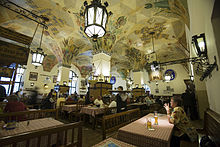Beer palace
A beer palace or a beer hall is a type of restaurant that became particularly popular in 19th century Central Europe . In brewery cities such as Munich , Dortmund , Berlin , and Graz , halls of up to 1500 m² were built, often in connected breweries with cozy breweries (also called beer houses ).
The palaces were created in the course of romanticism , the rising national consciousness and the associated recourse to the Middle Ages, when beer was also accepted as a drink by higher social classes. Above all, the breweries erected representative buildings that were reminiscent of industrial buildings in their size and were supposed to be able to accommodate the whole people and all social classes. These beer halls were then also generally used for festive events because the existing festival halls in the traditional inns were no longer sufficient.
In a deliberately simple historicist style, often with ironic references to “old German” drinking habits in the decoration, these buildings often developed into important hallmarks of the city. This applies in particular to Munich: there, for example, the Hofbräuhaus , the Mathäser, the largest beer tavern in the world at the time, the Löwenbräukeller or the beer palace at the brewery zum Münchner Kindl were built .
Beer palaces were popular until the end of the 19th century and led to the export of the design to the rest of Europe. Around 1900, social changes slowed this trend until after the First World War no new beer palaces were built at all.
literature
- Uli Walter: beer palaces. To the history of a building type . Dissertation, LMU Munich 1992 ( online )
Web links
Individual evidence
- ↑ cf. for example a calendar of events for the ball season from Graz, 1868, in: Grazer Volksblatt No. 45, February 15, 1968, supplement ( digitized, Google, full view ).
